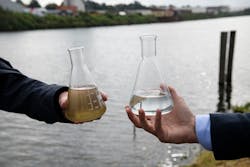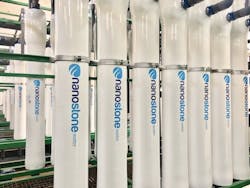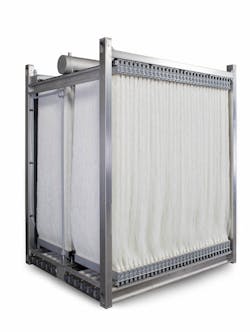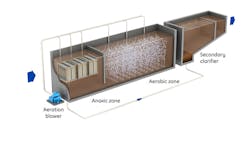About the author:
Carol Brzozowski is a freelance writer for WWD. Brzozowski can be reached at [email protected].
With the American Society of Civil Engineers (ASCE) giving the U.S. wastewater infrastructure a D+, the time is right for innovations to mitigate inherent challenges. According to the ASCE, the nation’s more than 16,000 wastewater treatment plants are functioning, on average, at 81% of their design capacities while 15% have reached or exceeded it.
Among the challenges: growing urban environments are placing greater wastewater demands on facilities. The cost is increasing to address operation and maintenance needs at treatment plants and collection networks near the end of their lifespans.
According to the ASCE, estimates indicate that utilities spent more than $3 billion in 2019 to replace almost 4,700 miles of pipeline nationwide. Asset management plans enable 62% of surveyed utilities to proactively manage wastewater infrastructure maintenance.
The wastewater sector is addressing current and future needs through resilience-related planning and innovations offered by manufacturers.
Nanofiltration
Case in point: NX Filtration, a Netherlands-based global provider of direct nanofiltration technology designed for pure and affordable water, recently received the 2021 Frost & Sullivan Global New Product Innovation Award in the water and wastewater treatment membrane industry.
The award follows another given last year by GWI for ‘Breakthrough Technology Company of the Year.’
For the Frost & Sullivan award, NX Filtration was recognized for its direct nanofiltration membranes that remove in one step micropollutants—including pharmaceuticals, medicines, PFAS, and insecticides, color and selective salts as well as bacteria, viruses, and nanoplastics—from water while offering strong sustainability benefits.
NX Filtration was chosen by Frost & Sullivan’s global team of analysts among markets and companies on criteria related to new product attributes, including matching market needs, reliability, quality, positioning, and design. Other factors include its impact on the end user in terms of price and performance value; purchase, ownership and service experience; customer service experience; and brand equity.
“Both these awards emphasize the breakthrough character of our unique hollow fiber nanofiltration membranes,” said Michiel Staatsen, NX Filtration CEO.
The company’s technology removes micropollutants in a manner requiring less energy and fewer chemicals.
Resilient Membrane Materials
The base material for the company’s membranes is PolyEtherSulfone (PES), designed to provide an ideal chemical and thermal stability for use in robust filtration processes. PES enables the production of membranes with very small pore sizes and narrow pore size distribution. The headers are designed to enable a low footprint of the modules in a skid, utilizing standard connections when possible.
High-end potting is achieved through high resistant (thermal, chemical, mechanical) epoxy resin with FDA and potable water approvals. It has a modular design for optimal flow conditions while ensuring high packing densities.
The dense support structure is designed for high pressure rating and with either positive or negative charge to ensure optimal selective layer adhesion, enabling process integrity during backwashing.
The first selective layer is applied in-line using a proprietary process designed to save resources and prevent defects. Selectivity based on a polyelectrolyte multilayer that is applied in a layer-by-layer manner allows for precise control of the membrane properties on a nanometer level.
End users represent the drinking water and wastewater reuse sectors in municipal and industrial water treatment plants.
Paul Hudson, industry analyst at Frost & Sullivan, notes that “climate change today leads to increasing water scarcity and water contamination. Frost & Sullivan recognized NX Filtration’s direct nanofiltration membranes’ ability to address such challenges.
“The company displays highly effective and resilient properties that allow users to achieve high selectivity at nanoscale,” Hudson said. “By utilizing NX Filtration’s membrane solutions, companies can achieve higher efficiency in a sustainable process unmatched by the competition.”
Membrane Aerated Biofilm Reactor
One of the new products SUEZ has developed is ZeeLung, a membrane aerated biofilm reactor (MABR) designed to treat wastewater in a small footprint. It is optimal for upgrading existing wastewater treatment plants in communities experiencing sudden growth or more stringent regulatory changes.
ZeeLung cassettes are inserted into existing infrastructure and support the growth of bacteria on the surface.
“It transfers oxygen to the bacteria very efficiently because it works on the principle of the molecular diffusion as opposed to the mechanism of forced draft aeration,” said Glenn Vicevic, executive, product manager for SUEZ - Water Technologies & Solutions. “In more conventional wastewater plants, a large blower sends the air through small holes in a pipe manifold to generate bubbles for the transfer of oxygen.”
Molecular Diffusion
In contrast, ZeeLung uses molecular diffusion where a fiber selectively passes oxygen only when the bacteria need it.
“It’s like the bacteria are the operators of the device rather than instruments and controls,” Vicevic added.
Its design is in response to what the company views as necessary paradigm shifts toward creating low energy and hyper-efficient wastewater treatment plants that do not consume excessive resources, Vicevic said.
The product enables the treatment of up to 50% more wastewater in the same footprint because it is an intensification device. Similarly, it enables a plant to also reduce its overall energy consumption by up to 50%, he says.
ZeeLung also creates additional value toward sustainability by addressing N2O release during nitrogen removal in wastewater treatment, which Vicevic said is the one of the most potent greenhouse gases (approximatly 300 times that of CO2).
“Our process releases much less N20,” he said.
Additional factors that should be considered when building or retrofitting a wastewater treatment plant center on ‘future-proofing’, Vicevic noted.
“In the case of climate change—if that’s a future objective—then avoiding the generation of N20 gas, for instance, is certainly a lot easier and less expensive to do at the beginning than after the fact,” he said.
Vicevic also encourages those planning wastewater infrastructure investments to “do your research widely because some of these technologies have not been fully communicated yet and that the opportunities are extensive.”
Looking ahead, Vicevic says there are many more opportunities to utilize the bacteria used in wastewater treatment in innovative ways. Suez is exploring different applications involving growing specific bacteria on the ZeeLung fiber.
One example is anammox bacteria, a strain that, while particularly efficient for wastewater treatment, is “finicky and it doesn’t grow very easily,” Vicevic said.
“You can enable the usefulness of the bacteria through deployment on the ZeeLung fiber. We’re trying to make the ideal matrix for the bacteria to live where they have all the nutrients, all the oxygen and an environment where they can be sustained there,” he said, adding the company also is contemplating a suite of ‘apps’ utilizing ZeeLung as the basis for deployment.
Ultrafiltration
Nanostone has focused its recent efforts on nanomaterials and optimizing the production and application of ceramic membranes for global applications.
In the U.S., the particular focus is on municipal use to treat challenging drinking water sources while providing robust operations. The company’s ceramic structure is fabricated using nano-materials and incorporates a specialized nano-coating to create an ultra-filtration membrane with a tightly-designed 30-nanometer pore size for reliable removal for suspended solids and pathogens.
Ceramic Fabrication & Materials
Nanostone uses a segmented monolith design enabling unrestricted permeate flow along the module’s entire length. This design minimizes the potential for flow restrictions and unnecessary pressure drops and maximize the surface area, according to Abigail Antolovich, Nanostone North America sales director.
The manufacturing process efficiency improvements have helped facilitate a higher throughput and created a more economically-accessible product for end users, Antolovich said.
The modules are designed for a high flow rate. The system is user-friendly because of the higher surface areas and larger flow channels and its construction is designed for simple polymeric membrane conversions into existing membrane racks, she added.
The system is designed to provide a robust option for municipal end users facing more challenging surface waters and other groundwater sources such as those with highly variable levels of suspended solids or organic materials.
“We’re thinking about our product application and development to meet end user challenges associated with accessing new water sources and existing operational challenges. It is driving customers looking for something that’s robust,” Antolovich said. “The ceramic material and Nanostone’s unique application help minimize or eliminate the possibility of breaking that membrane while enabling end users to expand their water resource options.”
Nanoparticle Coating
Additionally, the membrane’s flow channel and surface area structure enable end users in high growth regions where land is either at a premium or they are landlocked to gain a greater throughput—in some cases up to 40%—through their facility in retrofitting an existing footprint, Antolovich says.
“End users have growing water demands in their service areas,” she adds. “Either the land value around them is very high because of development or they just don’t have a lot of land. That’s helping to drive some of those innovations as well.”
The special nanoparticle coating creates a precise pore distribution size across the membrane, increasing the reliability of the removal of suspended solids and pathogens, Antolovich said.
“The ceramic material helps minimize the potential for fouling without having to sacrifice throughput either having to decrease flux or having downtime associated with polymeric membrane pinning or breakages,” she adds.
“The segmented design combined with large flow channels helps minimize flow restrictions and creates a very even distribution throughout the module.”
It also minimizes pressure drops, which ultimately means the energy requirements for pushing water through a membrane is less, Antolovich notes.
Retrofitting & Modularity
In retrofit projects, the duration of the construction can be shortened due to the configuration that enables simple retrofits in existing membrane racks.
“Whether it’s a greenfield site or a retrofit, it creates an option to put in a modular system rather than requiring major civil works,” she said.
The system also is designed to help end users meet water quality goals, including upstream pre-treatment and downstream treatment. Nanostone has designed the cleaning process as such to minimize extra steps and extra chemicals.
“We don’t need an air back pulse, which also helps to save energy and equipment costs,” Antolovich said. “We typically see recovery rates of 95% or greater that help end users keep the footprint small.”
Considering the entire treatment train, in a retrofit, end users are saving money, simplifying operations on upstream coagulants and seeing more efficient operations on downstream treatment processes, Antolovich added.
“For greenfield sites, because we can operate in direct filtration mode where an end user can use in-line coagulation, there’s an opportunity to eliminate some of the bigger footprints and more complex civil works needed for upstream treatment,” she said. “It helps end users maximize their footprint in terms of getting the throughput and helps them minimize a lot of extra chemical and energy usage. If you look at a 20-year life cycle, it creates an economically attractive treatment train.”
Membranes have been around for quite a while in different configurations and different types of materials.
“Ceramics create another option for end users who would otherwise have more difficulty treating difficult water sources or they might have to run facilities at lower capacities to accommodate limitations of existing processes,” Antolovich said. “It creates a much more robust option for municipalities as it gives them the opportunity to tap into sources with a lot more confidence than they might otherwise have to maintain their plant capacity to that level.”
With not having to choose between having to run at a lower capacity or work with challenging waters, end users now have an option to maintain or increase plant capacity while producing consistently high quality from challenging water sources.
About the Author
Carol Brzozowski
Carol Brzozowski is a freelance writer for Wastewater Digest. Brzozowski can be reached at [email protected].




